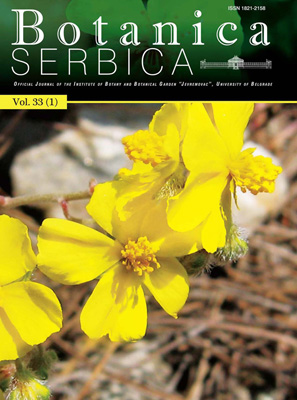
Volume 33 Issue 1 2009 |
|
History and tradition of the oldest botanical journal in serbia „Glasnik instituta za botaniku botanicke bašte univerziteta u Beogradu“, now re-nominate as „Botanica Serbica“ STEVANOVIC, B. Pages 5-11 Full reference | First page | Full text PDF |
|
Helianthemum marmoreum (Cistaceae), a new species from the Central Balkans STEVANOVNIC V, MATEVSKI V & TAN K. Pages 13-19 Full reference | Abstract | Full text PDF |
KEY WORDS: Helianthemum (Cistaceae), new species, taxonomy, endemic, Balkan peninsula |
| Molecular reappraisal confirms that the Campanula trichocalycina-pichleri complex belongs to Asyneuma (Campanulaceae) STEFANOVIC S & LAKUŠIC D. Pages 21-31 Full reference | Abstract | Full text PDF |
KEY WORDS: Balkans, Campanulaceae, molecular phylogeny, Asyneuma, Campanula, Physoplexis, Petromarula, trnL-F. |
| Threat status revision of some taxa from “The Red Data Book of Flora of Serbia 1” TOMOVIC G, ZLATKOVIC B, NIKETIC M, PERIC R,LAZARAVIC, P., ŠEMIJA D, STANKOVIC M, LAKUŠIC D ANACKOV G, KNEŽEVIC J, SZABADOS K, KRIVOŠEJ, Z., PRODANOVIC, D., VUKOJCIC S, STOJANOVIC V, LAZAREVIC M & STEVANOVNIC V. Pages 33-43 Full reference | Abstract | Full text PDF |
KEY WORDS: vascular flora, Serbia, extinct species, critically endangered species, distribution |
| Genus Leucojum L. (Amaryllidaceae) – distribution and threatened status in Serbia JOVANOVIC S, TOMOVIC G, LAKUŠIC D, NIKETIC M, PAVLOVIC M & BOŽA P. Pages 45-50 Full reference | Abstract | Full text PDF |
KEY WORDS: Leucojum, distribution, ecology, threatened status, Serbia |
| Leaf anatomy of the Sesleria rigida Heuffel ex Reichenb. (Poaceae) in Serbia KUZMANOVIC N, ŠINŽAR-SEKULIC J & LAKUŠIC D. Pages 51-67 Full reference | Abstract | Full text PDF |
A detail analysis has shown that local populations are anatomically very well differentiated into the serpentine populations from western and carbonate populations from eastern Serbia. KEY WORDS: Poaceae, Sesleria rigida, leaf-anatomy |
| Effects of air pollution on needles of Cedrus atlantica (Endl.) Carriere in industrial area of Pancevo (Serbia) MARIN M, KOKO V, DULETIC-LAUŠEVIC S & MARIN PD. Pages 69-73 Full reference | Abstract | Full text PDF |
KEY WORDS: Cedrus atlantica, needle, air pollution, stereology, histology |
| The influence of gypsiferous substrata on bryophyte growth: are there obligatory gypsophilous. BOGDANOVIC M, SABOVLJEVIC M, SABOVLJEVIC A & GRUBIŠIC D. Pages 75-82 Full reference | Abstract | Full text PDF |
KEY WORDS: bryophytes, mosses, gypsum, gypsophytes, Atrichum undulatum, Bryum argenteum |
| Effects of day length on photosynthetic pigments and antioxidative metabolism of in vitro cultured Atrichum undulatum (Hedw.) P. Beauv. (Bryophyta) CVETIC T, SABOVLJEVIC A, BOGDANOVIC PRISTOV J & SABOVLJEVIC M. Pages 83-88 Full reference | Abstract | Full text PDF |
KEY WORDS: moss, Atrichum undulatum, photoperiod, vegetative phase, antioxidative metabolism |
| Desmid flora (Chlorophyta, Zygnematophyceae) of the River Tisa in the Province of Vojvodina (Northern Serbia) STAMENKOVIC M & CVIJAN M. Pages 89-99 Full reference | Abstract | Full text PDF |
KEY WORDS: Desmids, the river Tisa, Vojvodina, Serbia |
| Cyanobacterial, algal and fungal biofilm on sandstone substrata of Eiffel`s Lock in Becej (Serbia) LJALJEVIC GRBIC M, SUBAKOV-SIMIC G, KRIZMANIC J & LAÐIC V. Pages 101-105 Full reference | Abstract | Full text PDF |
KEY WORDS: micromycetes, photosynthetic organisms, biofilm, biodeterioration, cultural heritage |
| Isolation and characterization of endophytic non-rhizobial bacteria from root nodules of alfalfa (Medicago sativa L.) STAJKOVIC O, DE MEYER S, MILICIC B, WILLEMS A & DELIC D. Pages 107-114 Full reference | Abstract | Full text PDF |
KEY WORDS: alfalfa, endophytic bacteria, plant growth promotion |


